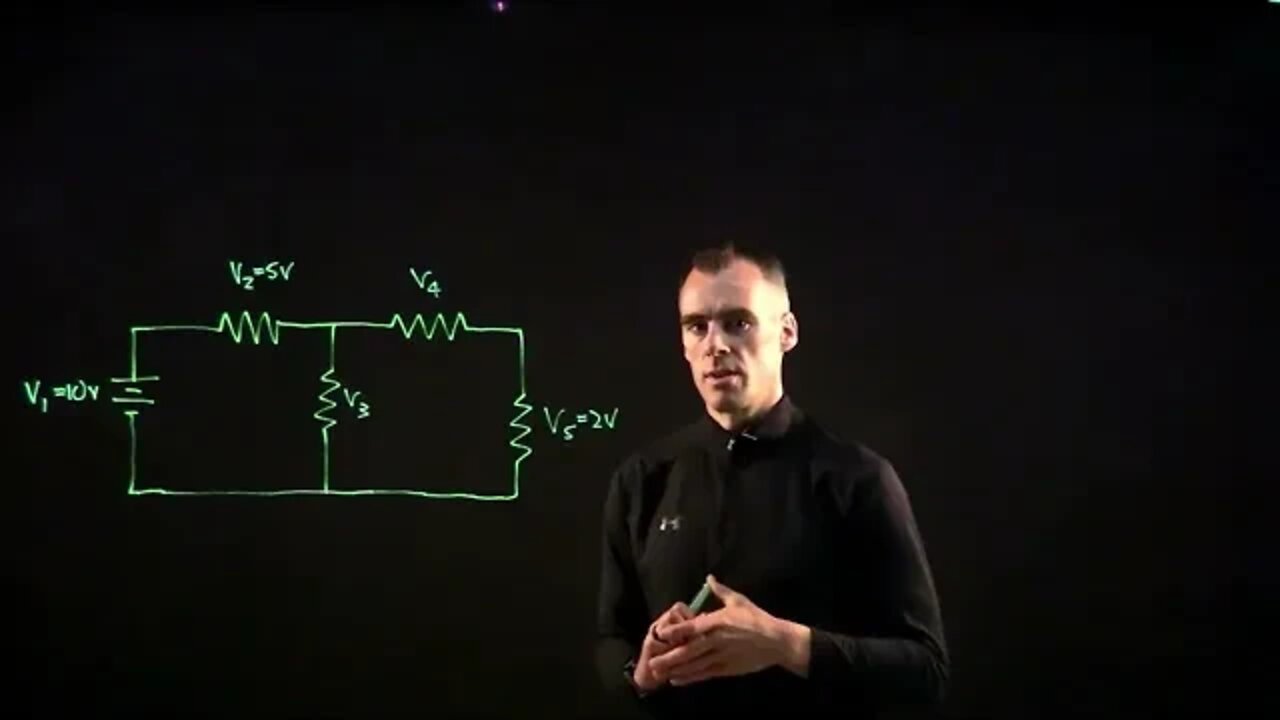Premium Only Content

Finding Voltage using Kirchhoff's Voltage Law (example problem)
This video shows how to use Kirchhoff's Voltage Law (KVL) to find voltages for a simple circuit with 3 loops.
Below is the basic script:
OK so let's go ahead and apply KVL to this circuit here. So notice this symbol is for a voltage source and these other symbols are for resistors. So if current is going clockwise here, it makes sense that the + and – are on different sides here right, because the voltage source adds voltage, while the voltage will drop across the resistors.
So for a simple example, let's say we know V_1, V_2 and V_5 in this case, and we want to find the voltage drop across V_3 and V_4.
For this we can use KVL.
So first thing we do is draw the loops. There are 3 closed loops here, let's draw them out and call them loop 1, loop 2 and loop 3.
For loop 1, we start in the bottom left corner and start adding the voltages, knowing they will sum to 0. Consistency with the +/- signs is very important here, because as discussed, the voltage source behaves differently than the resistors. So for consistency we start with the sign we run into first along our clockwise path. For V_1, we hit the minus sign first, so we start our equation with –V_1. Next we hit V_2 on the plus side, so we add V_2, then we hit V_3 on the plus side, so we add V_3. This gets us back to our starting location, so we know based on KVL these must sum to 0. That's our first equation.
We can either use loop 2 or 3 to solve this, so let's just use loop 2 since it maybe helps to clarify a bit more.
For loop 2, we start at the bottom left. We first hit V_3 and since we hit on the negative side, we start with –V_3. Now you may be thinking this is a resistor so we should always consider these positive, but this is important, you just have to be consistent with the +/- sides we assigned and with the direction of our loop. So we start with –V_3 first, then +V_4, then +V_5 and we are back to our starting location, knowing these sum to 0.
Now this is all we need, 2 equations and 2 unknowns.
We first solve for V_3 from our loop 1 equation.
Then plugging that V_3 value into our loop 2 equation, we solve for V_4, and we're done.
Now if we had 3 unknowns, say we weren't given our source voltage V_1, we could have solved for that too by also using the loop 3 equation, which would have given us 3 equations to solve for 3 unknowns.
But that provides a basic example of how to use Kirchoff's Voltage Law, so hope it was helpful, and until next time, take care.
-
 30:14
30:14
Robbi On The Record
1 day ago $0.22 earnedYou’re Out of Alignment: Spiritually, Mentally, Physically. Here’s Why. ft Dr. Rich
1.24K1 -
 LIVE
LIVE
LadyDesireeMusic
4 hours ago $0.34 earnedDaily White Pill- Music & Chat
94 watching -
 1:33:25
1:33:25
Jeff Ahern
2 hours agoThe Saturday Show with Jeff Ahern
6.51K5 -
 LIVE
LIVE
Spartan
1 hour agoHalo 3 MCC Throwback Charity Tournament for Men's Mental Health | Kuhlect Mental Riqhts Spartan
27 watching -
 LIVE
LIVE
GrimmHollywood
2 hours ago🔴LIVE • GRIMM HOLLYWOOD • SGT WILKY'S WARZONE PALOOZA 2 •
70 watching -
 20:36
20:36
It’s the Final Round
2 hours ago $2.49 earnedNBA Best Bets & Player Props | Full Analysis & Predictions, FREE Today (Saturday 11/9) November 9th
11.5K1 -
 LIVE
LIVE
The Real Tombliboos - Live Streaming
13 hours ago $0.51 earned🎮 Charity Stream for Extra Life 4 Kids! ❤ Supporting Texas Children’s Hospital ! 🙌
103 watching -
 LIVE
LIVE
Amarok_X
3 hours ago🟢LIVE | BF6 REDSEC | OPERATION 100 FOLLOWERS | VETERAN GAMER
13 watching -
 18:08
18:08
Professor Nez
4 hours ago⚠ Charlie Kirk WARNED America about Zohran Mamdani
12.1K46 -
 LIVE
LIVE
GritsGG
2 hours ago#1 Most Warzone Wins 3943+!
26 watching